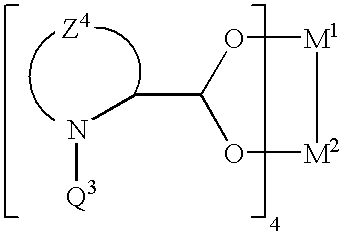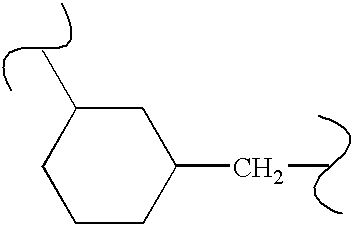Dirhodium catalyst compositions and methods for using same
a technology of dirhodium catalyst and composition, which is applied in the direction of catalyst activation/preparation, metal/metal-oxide/metal-hydroxide catalyst, etc., can solve the problem of the expense of rhodium metal catalysts, and achieve the effect of increasing the efficiency of dirhodium catalys
- Summary
- Abstract
- Description
- Claims
- Application Information
AI Technical Summary
Benefits of technology
Problems solved by technology
Method used
Image
Examples
example 1
Cyclopropanation Reactions with Rh2(S-DOSP)4 as Catalyst
[0156]In order to determine the minimum amount of catalyst that would be required to decompose diazo compounds, the reaction of styrene with phenyldiazoacetate using decreased amounts of Rh2(S-DOSP)4 along with and without methyl benzoate (1 equivalent based on the amount of phenyldiazoacetate) was examined. The results are presented in Table 1. All reactions were carried out at room temperature in hexanes. On using 0.1 mol % of Rh2(S-DOSP)4 (entries a and b in Table 1), the reaction proceeded with very good yield and ee but failed to reach completion with 0.01 moles of Rh2(S-DOSP)4 (entries c and d). Surprisingly with 1 equiv. of methyl benzoate and 0.01 mol % of Rh2(S-DOSP)4, (entries e and f in Table 1), decomposition of phenyl diazoacetate in presence of styrene resulted in high ee. The reaction did not reach completion when 0.001 mol % of Rh2(S-DOSP)4 was used. It was hypothesized that the drop in enantioselectivity could ...
example 2
Cyclopropanation Reactions with Rh2(S-biTISP)2 (Formula XII (R1=R2=2,4,6-triisopropyl-phenyl)) as Catalyst
[0159]Rh2(S-biTISP)2 catalyzed decomposition of phenyldiazoacetate in the presence of styrene in CH2Cl2 at room temperature resulted in cyclopropanation product in 90% ee (Davies et al., Tetrahedron Lett., 40:5287 (1999), which is hereby incorporated by reference). One of the most interesting and distinctive features of Rh2(S-biTISP)2 catalyzed reactions is that these reactions typically exhibit higher enantioselectivity in CH2Cl2 vis a vis hydrocarbon solvents (e.g., hexanes or pentanes). The reaction of styrene with phenyldiazoacetate using decreased amounts of Rh2(S-biTISP)2, with and without methyl benzoate as additive was carried out. The results are presented in Table 2.
[0160]
TABLE 2amount ofRh2 (S-biTISP)2,additive,isolatedentrymol %equiv.yield, %ee, %timea0.1—72891 hb0.1182891 hc0.01—XXXd0.01179893 he0.001———6 d *f0.0011——6 d ** Reaction did not go to completion.
The cycl...
example 3
Intermolecular C—H Insertion Reactions with Rh2(S-biTISP)2 (Formula XII (R1=R2=2,4,6-triisopropyl-phenyl)) as Catalyst
[0178]Intermolecular C—H insertion reactions with low catalyst loading were then attempted, as shown in the following reaction scheme:
[0179]
More particularly, Rh2(S-biTISP)2 (0.1 mol %) catalyzed the decomposition of phenyldiazoacetate in the presence of 1,4-cyclohexadiene in dichloromethane at room temperature in the presence of molecular sieves with methyl benzoate resulted in C—H insertion product. No trace of cyclopropanation product was observed. The diene was hydrogenated with H2 / Pd—C in methanol to give the cyclohexane derivative in 77% yield (two steps) and 15% ee.
PUM
| Property | Measurement | Unit |
|---|---|---|
| temperature | aaaaa | aaaaa |
| temperature | aaaaa | aaaaa |
| temperatures | aaaaa | aaaaa |
Abstract
Description
Claims
Application Information
 Login to View More
Login to View More - R&D
- Intellectual Property
- Life Sciences
- Materials
- Tech Scout
- Unparalleled Data Quality
- Higher Quality Content
- 60% Fewer Hallucinations
Browse by: Latest US Patents, China's latest patents, Technical Efficacy Thesaurus, Application Domain, Technology Topic, Popular Technical Reports.
© 2025 PatSnap. All rights reserved.Legal|Privacy policy|Modern Slavery Act Transparency Statement|Sitemap|About US| Contact US: help@patsnap.com



